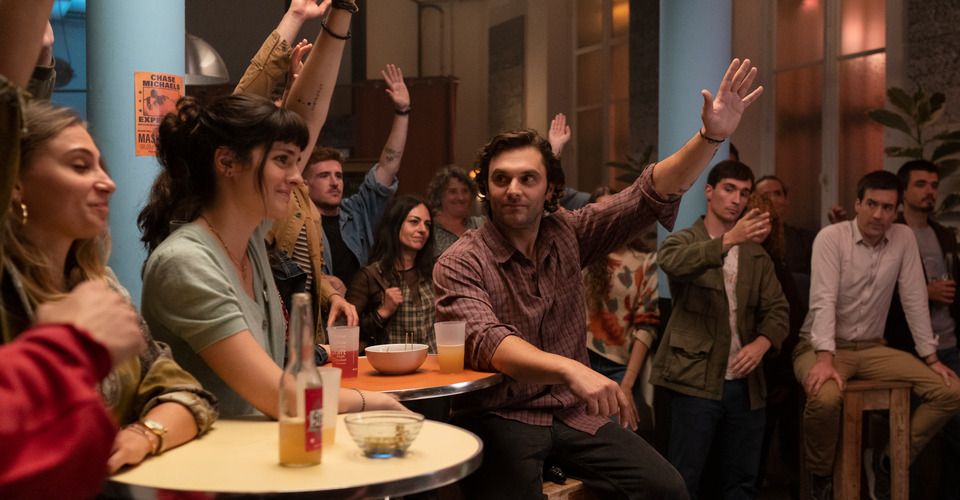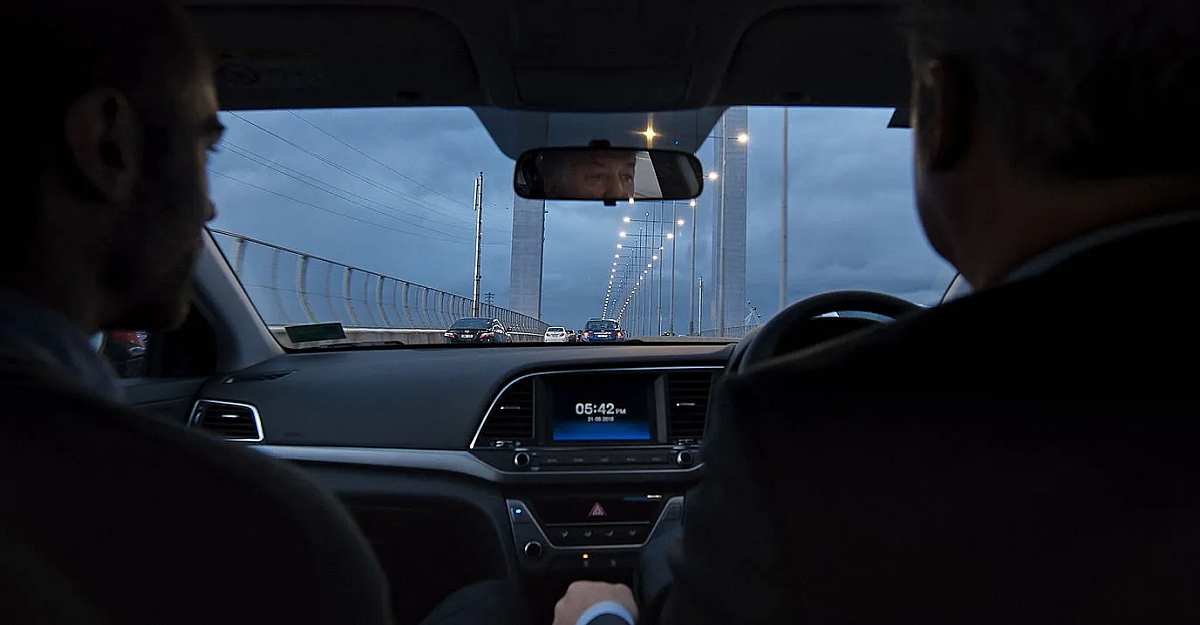On the tail of a series of sublime and haunting Australia Crime pictures to release in the post-pandemic era, Limbo joins a canon of thoughtful, skilfully made films that present a harrowing subtext about Australian society, and the inherent violence that permeates it, focusing on the Indigenous Australian struggle for the excavation of an ongoing history of oppression by the hands of White Australia. It is written, directed, scored and shot by Ivan Sen—an Indigenous filmmaker with a pedigree of thoughtful films, such as Mystery Road (2013), Toomelah (2011), and Beneath Clouds (2002), that express the entanglements and tragedies that adopt Indigenous perspectives as well as utilising stark outback and rural settings.
The narrative, shown in stark and saturated black and white, is centred around Travis Hurley, a police investigator, drug addict and white man (played by a gnarled and haggard-looking Simon Baker) sent into the fictional opal town of Limbo to review the twenty-year-old case of a missing girl, Charlotte. Instead of landing on a formulaic mystery-cum-thriller about a fish-out-of-water detective trying to uncover the truth in a hostile community, Sen uses the baseline form to tell a poignant tale of the open wounds in the land and people, torn open by colonisation, as well as asking what might be done to heal these wounds, on an individual and cultural level.
While the story of Limbo is fictional, Sen works within a framework of quasi-historical reinterpretation of real crimes, in the manner recently of other Australian Filmmakers such as Justin Kurtzel (Nitram, 2021) and Tom Wright (The Stanger, 2022): it therefore evokes several cases of unsolved murders, perpetrated against Indigenous peoples and disregarded by a parochial, racist legal system.
The particulars of the story have certain elements in common with the Bowraville Murders, which took place in mid-North coast of New South Wales during the early 1990s, and the subsequent attempts of family at seeking justice. Sen, perhaps wisely, doesn’t feel the need to focus on minutiae in the case, seeing the crimes as holding universal aspects of atrocity experienced communally by Indigenous people in a settler-colonial paradigm. In so doing, like those other filmmakers, Sen allows his work to be more diagnostic, strengthening the few, precious prescriptive aspects littered throughout the film.
While the central crime of Limbo is subtly addressed, it is less pertinent than the exploration of the damage and struggles of the characters to reckon with the trauma of their family-member’s sudden disappearance, with following waves of loss and grief experienced from the injustice. The film is unflinching in pointing the finger at the unjust system of continuing colonial violence, enacted viciously through the police, but also systematically by means of economic and social privileges. Marginalisation is continuosly enforced, as opposed to deriving solely from the initial incursion of Western society.
The environment is used to excellent effect by the director, with the open spaces of rural landscapes contrasting with the claustrophobia of its interior scenes: caravans, old mines, windowless structures carved from the stone. This centring of the extreme extractivism expresses a physical manifestation of state-sanctioned violence that scar both the land and its inhabitants equally. It is in the former environs that the enormity and distance of time and place are felt, especially in relation to the narrative’s central investigation); while in the latter, characters are forced to reckon with their inner turmoil. Scenes are split between this vertiginous dialectic without resolution, and the audience is seldom left to rest comfortably within a scene, yearning for space and breath as much as the characters.
The central metaphor of Limbo is all but explicitly raised in a pious narration in the town’s church, whose cosmic ethos places individuals halfway between salvation and damnation. The closer one is to God, they are ‘in a golden light’, while if one moves further away, ‘the golden light turns red, and in the red light are the damned.’ It is through this metaphor that a likely culprit for Charlotte’s disappearance, Leon, emerges—a suspect who the police had failed to investigate. Throughout the film, there are multiple witnesses who attest to how much he ‘likes black girls’, as well as harrowing reports of drugging, and implied sexual assault, following from parties that he threw prior to Charlotte’s disappearance. But, just as Charlotte is absent from the narrative, so is Leon: the closest we get to meeting him is through old tapes and the accounts of those who knew him—including a self-proclaimed brother, Joseph, who points towards a stony grave, claiming that his brother died a year before, stricken by dementia, to the point where ‘he didn’t even know his own name anymore’.
At the same time, a pervasive narrative thread throughout the film hints at the possibility that Leon may not be dead after all. On the old case tapes, he claims to be a pious man who visits the community’s church every Sunday. A knowledge of the Biblical Joseph—known for his moral superiority to immoral brothers, and who overcomes a false accusation of rape and is elevated because of his sobriety, monogamy and righteousness—allows to viewer to interpret the ‘Joseph’ on-screen as a flimsy construct made by a collapsing, guilt-ridden mind, eager to seek redemption, but unwilling to take any accountability.
The position of Leon/Joseph within his community, and how he was allowed to escape justice, are also explored, painting a compelling picture of where the fault-lines of marginalism occur in an already marginal space in society. Old witnesses reflect on the wild days of their youth, during which they fell prey to the abusive elements of their society, as a response to the social pressures they experienced daily. The mental toll of colonisation causes more horrors, as the need to escape becomes an inevitable need for solitude. The character of Charlie (played with overpowering remorse and yearning by Rob Collins) exemplifies this lifestyle, putting on the pantomime of self-sufficient masculinity but intermittently breaking down as the trauma of the past constantly assails him.
Limbo, however, goes out of its way to show that this dislocation isn’t fully the result of forced enculturation by colonial power: there are other social barriers, some preexisting, which cause further alienation in individuals. Charlie, despite living in the same town, is estranged from his son, Zac, and daughter, Ava, who are left in the stewardship of their aunt, Emma (played with stoic decency by Natasha Wanganeen). As Travis views a picture that Charlotte painted before her disappearance, he is informed of the symbolism of the work: ‘Family, sister, brother, mother,’ with the figure of the father painted ‘separate from the family.’ Shared symbols and iconography passed down to her nieces in the next generation of the present-day, where the same patterns of social behaviour which left Charlotte vulnerable, are still active and relevant.
The forced reconciliation between father and son engineered by Travis might come across as parochial, commandeering and privileged, were it not for Sen’s empathetic writing and Baker’s portrayal of Travis’ fraught attempts at navigating his authority and irrepressible desire for connection. Travis’ addiction—the product of his past in drug enforcement—wears away many of the pretences and hypocrisies of his authority. His vulnerable, earnest confession to Emma, ion which he laments the breakdown of his relationship with his ex-wife and son, and his inadequacies in the roles of partner, father, and authority figure, makes his position as a reluctant, but well-meaning protagonist, more believable.
In the end, whatever improvement there has been in the relationships between the characters comes from a realisation that some pains and traumas cannot be resolved through their excavation and appraisal, but through a resolve to hold onto what remains in one’s life, in spite of the pain.
The fate of Charlotte’s family is far fairer than the one of Leon/Joseph—hounded by invisible phantoms of his past, tossing in self-made squalor, alone, and perpetually stuck in a psychological cycle of guilt and self-deception. Whether or not his dementia is real or feigned, it speaks to a mindset that modern Australia exemplifies well: fluctuating between self-pitying hand-wringing and obfuscating innocence by means of self-administered amnesia, with nothing but a legacy of lies to leave behind. It is clear that, if salvation is to come for the inhabitants of Limbo, it can’t be bestowed from God, or anyone up on high, but through the mutual actions of those who suffer, and genuinely wish to heal and live, together.
Limbo is currently available to watch on ABC iView.



